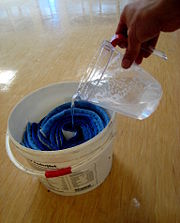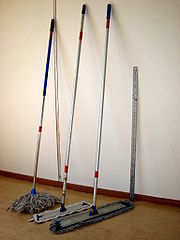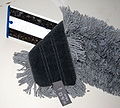
Mop
Encyclopedia

Floor cleaning
Floor cleaning is a major occupation throughout the world. The main job of most cleaners is to clean floors.-Reasons for cleaning floors:The principal reasons for floor cleaning are:...
and other surfaces, or to mop up dust, or for other cleaning purposes. The word (then spelled mappe) is attested in English as early as 1496, but new refinements and variations of mop designs have been introduced, from time to time. For example, American
United States
The United States of America is a federal constitutional republic comprising fifty states and a federal district...
inventor Jacob Howe received U.S. patent #241 for a mop holder in 1837 and African American
United States
The United States of America is a federal constitutional republic comprising fifty states and a federal district...
inventor Thomas W. Stewart (U.S. patent #499,402) in 1893.
Classic yarn mop for wet use

Yarn
Yarn is a long continuous length of interlocked fibres, suitable for use in the production of textiles, sewing, crocheting, knitting, weaving, embroidery and ropemaking. Thread is a type of yarn intended for sewing by hand or machine. Modern manufactured sewing threads may be finished with wax or...
mop. The mop (eye) consists of thick lengths of yarn (about 25 cm / 10 in) or, in newer models, soft strands of water-absorbing fabric. A yarn mop is usually mounted on a long (about 1.5 m or 5-foot) handle with a threaded-screw end on which the mop can be fastened by turning it clockwise.
To clean a floor, the mop is soaked in a bucket
Bucket
A bucket, also called a pail, is typically a watertight, vertical cylinder or truncated cone, with an open top and a flat bottom, usually attached to a semicircular carrying handle called the bail. A pail can have an open top or can have a lid....
of water, into which some cleaning solution has usually been added, and swept against the floor surface. Some buckets include a wringer to strain excess water from the mop, to control the amount of water transferred to the floor. Leaving excess (contaminated) water on the floor will result in a dirty residue.
Dry-mop, dust-mop

Microfiber
Microfiber or microfibre refers to synthetic fibers that measure less than one denier. The most common types of microfibers are made from polyesters, polyamides , and or a conjugation of polyester and polyamide.Microfiber is used to make non-woven, woven and knitted textiles...
and is used as a first step in cleaning a floor.
Professional dry mops consist of a flat sheet of micro fiber textile or sheets with a surface of looped yarn, usually about 15 cm wide, and comes in variable lengths (usually 30 – 100 cm).
The dry-mop can in many instances replace a broom and has the ability to hold a limited amount of dust or sand within itself. Ideally, it should be machine washed when it becomes saturated with dust. Another option is using a vacuum cleaner to suck surface dust away from the mop, however this is limited in its effectiveness.
Single-use dry-mops are also available and widely sold.
Wet-mop, moist-mop
A wet mop or moist mop is, in professional cleaning, used as in the second step in the cleaning of a surface. The wet mop is swept over the surface to dissolve and absorb fat, mud and dried-in liquid contaminations. Professional wet-mops consist of a flat sheet of microfiber textile or a sheet with a surface of looped yarn (which might contain microfiber as well), usually about 15 cm wide, and come in various lengths (usually 30 – 100 cm).Mops for pre-moisting

Mops for pre-moisting are flat sheets of (often microfiber
Microfiber
Microfiber or microfibre refers to synthetic fibers that measure less than one denier. The most common types of microfibers are made from polyesters, polyamides , and or a conjugation of polyester and polyamide.Microfiber is used to make non-woven, woven and knitted textiles...
) textile, usually about 15 cm wide, and comes in variable lengths (usually 30 – 100 cm). Mops for pre-moisting are fastening on a handle with a flat pad mount with the aid of velcro
Velcro
Velcro is the brand name of the first commercially marketed fabric hook-and-loop fastener, invented in 1948 by the Swiss electrical engineer George de Mestral...
or a pouch on the mop, in which the pad on the handle fits.
Pre-moisting
Pre-moisting can be done with a special washing machine or by hand by simply folding and packing the mops tight in a container and pouring the measured amount of water over them. The mops will then need about 5 – 10 minutes for the liquid to distribute evenly in their tissue before use.Advantages
- The cleaner does not have to have a bucket of water with him/her when sweeping the floor, but simply carries an appropriate amount of mops. This means the weight of the equipment can often be kept lower.
- The risk of over-wetting the floor and leave pools which collect dust is eliminated if the wetting is ideal.
Hot mop
The hot mop (or steam mop) follows a similar concept to a steam ironIron (appliance)
A clothes iron, also referred to as simply an iron, is a small appliance used in ironing to remove wrinkles from fabric.Ironing works by loosening the ties between the long chains of molecules that exist in polymer fiber materials. With the heat and the weight of the ironing plate, the fibers are...
. After adding water, the water is heated to make it exude on top of a floor, which can then be cleaned without using a cleaning solvent. These can work best on surfaces where a regular mop would also be used, such as bare floors, hearths, and laminate.
Syntho-mop
A syntho-mop such as the ScoobaScooba
Scooba is an automated robotic floor washer produced by iRobot. It was released in limited numbers in December 2005 for the Christmas season with full production starting in early 2006...
is not considered a mop, because even though it performs the same function as a traditional mop, the lack of hand operation makes it ineligible for status as a mop.
handles and mounting

- screwing (as with the classic yarn mop)
- velcro (as with many professional flat mops)
- pouch (as with many professional flat mops)
- clamp
- hanger (with strands doubled over the hanger)
.jpg)


